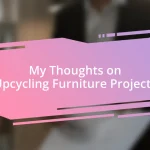Key takeaways:
- Prioritize eco-friendly materials and design elements, such as reclaimed wood and natural lighting, to create a sustainable home library that reflects personal values and enhances the reading experience.
- Organize books in a way that evokes emotions or themes, transforming the library into a space that fosters curiosity and encourages family engagement with literature.
- Regular maintenance of energy-efficient devices and sustainable sourcing of new books is essential for the longevity and vitality of a sustainable home library.

Understanding Sustainable Home Libraries
Understanding sustainable home libraries begins with a mindful approach to materials and resources. I remember dedicating time to research eco-friendly building supplies, discovering that reclaimed wood and low-VOC paints not only contribute to a green environment but also add character to my space. Isn’t it fascinating how the materials we choose can tell a story about our values?
When I think about sustainability, it’s not just about the physical space but also the philosophy that guides us. For instance, I’ve infused my library with a collection of both classic and contemporary books on sustainability and environmental stewardship. This creates a living resource for my family, turning the library into an educational hub that reflects our commitment to a greener future. Can a home library serve as a catalyst for change in our lives and communities? I believe it can.
Lastly, integrating technology to minimize resource usage can transform how we engage with literature. I often leverage online platforms for borrowing eBooks and audiobooks, reducing the need for physical copies. This not only saves space but aligns with my goal of creating a library that’s both sustainable and adaptable to the evolving nature of reading in our digital age. How do you envision your sustainable library serving the needs of your family while protecting our planet?

Planning Your Sustainable Library
When I started planning my sustainable library, I found that envisioning the layout was just as important as choosing the right materials. I mapped out spaces for relaxing reading nooks and shelving that captured natural light, fostering an inviting atmosphere. I learned that the library should be a sanctuary — a place that feels both nurturing and inspiring. Sometimes, it really is about how the space makes you feel.
Here are some key considerations to keep in mind as you plan:
- Natural Light: Design windows and openings to maximize daylight, minimizing reliance on artificial lighting.
- Zoning: Create areas for different activities — quiet reading, study zones, or family gatherings.
- Eco-Friendly Furnishings: Choose secondhand or sustainably sourced furniture to reduce your environmental footprint.
- Functional Layout: Consider how you and your family will interact with the space to optimize flow and usability.
- Personal Touches: Incorporate elements that reflect your family’s personality, like displaying favorite books or art made by your kids.
In the early stages, I fondly remember laying out a color-coded floor plan — a mix of practicality and my own personal “dream library” vision. My enthusiasm struck as I imagined my family sprawled out with their favorite books. It’s these moments of planning that truly underscore the heart of building something meaningful together.

Choosing Eco-Friendly Materials
Choosing eco-friendly materials is a crucial step in building a sustainable home library, and it can be a journey full of discovery. Personally, I found that sourcing local materials not only reduces transportation carbon footprints but also supports community businesses. For example, when I decided to use bamboo for my shelves, I felt a sense of pride knowing that it is a rapidly renewable resource. There’s something special about knowing the materials I chose were not just good for the planet but also enriched my local economy.
I remember the moment I stumbled upon reclaimed wood at a nearby lumberyard. The imperfections and knots in the wood carried stories from the past, inviting a sense of character into my library. Using this kind of material brought warmth to the space that new, factory-processed wood simply couldn’t replicate. Plus, the low-VOC (volatile organic compound) paint I selected for the walls significantly improved the air quality in my home, allowing my family to breathe easier as we immersed ourselves in our cozy reading spots.
It’s essential to weigh options carefully; sometimes, the choices can seem overwhelming. I often ask myself, “Is this sustainable? Will it benefit both my family and the environment?” Each time I hold a sustainably sourced bookcase or handle eco-friendly furnishings, I’m reminded of my values. It’s not just about aesthetics but the deeper connection to our home. The materials we choose echo our commitment to nurturing both our living space and the planet.
| Material Type | Environmental Impact |
|---|---|
| Reclaimed Wood | Reduces waste, conserves resources, and adds unique character. |
| Bamboo | Fast-growing and renewable; absorbs more carbon dioxide than trees. |
| Low-VOC Paints | Improves indoor air quality and reduces harmful emissions. |

Organizing Your Book Collection
Organizing your book collection can be as satisfying as crafting the library itself. I remember my early days of sorting through stacks of books, each filled with memories and stories. Initially, I tried an alphabetical system, but it felt too rigid for my eclectic taste. Instead, I opted for a more personal approach—grouping books by the emotions they evoke or their themes. It’s almost like each section tells a story of its own, and that makes me smile every time I walk by.
As I delved deeper into the organization process, I found that functional spaces really matter. For instance, I created a cozy reading corner with my favorite novels, while classics occupy another shelf that makes them feel special. It’s these little distinctions that not only make finding a book easier but also enhance the overall experience of enjoying my library. Have you ever considered how the way you arrange your books affects your reading habits? I certainly noticed that a well-organized collection led me to rediscover forgotten gems.
Lately, I’ve been experimenting with various display methods, such as staggering larger hardcovers with art pieces and smaller paperbacks. The visual appeal of my collection has improved immensely, drawing family members closer to it. I often find my children pausing to admire the arrangement or asking questions about the titles they see. Ultimately, every time I rearrange a book or add a new piece, I’m reminded that organizing is not just about functionality but also about creating an inviting space that beckons curiosity.

Incorporating Energy Efficient Lighting
Incorporating energy-efficient lighting made a significant difference in my home library. I remember the excitement of swapping out traditional bulbs for LED lights. Not only do they last longer, but they also consume a fraction of the energy. Have you ever noticed how warm LED light can make a space feel? I was pleasantly surprised by the soft glow that illuminated my reading nooks, creating a cozy atmosphere perfect for curling up with a good book.
Selecting lighting that enhances both efficiency and aesthetics often feels like walking a tightrope. I chose fixtures that complemented my library’s design while maximizing natural light during the day. The addition of dimmers, in particular, allows me to adjust the brightness depending on the time of day or mood. I find myself asking, “How do I want to feel in this moment?” By modifying the lighting, I can easily transition from an energizing vibe in the morning to a tranquil setting at night.
I must say, using energy-efficient lighting not only reduces my utility bills but also provides peace of mind about my environmental impact. There’s something truly satisfying about knowing that my library is both inviting and sustainable. When I switch on those soft, efficient lights, I often reflect on how the choices we make can create a nurturing space for ourselves and the planet at large. Have you considered how lighting can transform not just your space but also your experience of it?

Creating a Comfortable Reading Space
Creating a comfortable reading space has been a journey of trial and error for me. I vividly remember the first time I plopped down a large, cushy armchair in the corner, a once-empty spot that now feels like my personal retreat. It’s amazing how just a simple change in furniture can transform a space into a haven, inviting hours of quiet contemplation. Have you ever felt that rush of comfort when you find the perfect spot to read? That sensation is something I cherish.
As I explored further, I realized that texture plays a crucial role in comfort. Throw pillows and soft blankets became my best friends, turning ordinary seating into a cozy nest. I often find myself sinking into that chair, enveloped in warmth, which makes the reading experience so much more enjoyable. When I think about it, don’t you think the right fabrics can almost encourage you to dive into those pages? It’s fascinating how inviting elements can pull you into a different world, one book at a time.
Another fantastic aspect I discovered is the importance of personal touches. Surrounding myself with art, cherished photographs, and even a little plant have added character to my space. There’s a particular framed quote I love, which reads, “A room without books is like a body without a soul.” Each glance at that quote warms my heart, reminding me that this space isn’t just about reading; it’s about creating memories too. So, how do you adorn your reading area? A few thoughtful accents can turn a simple library into a reflection of who you are.

Maintaining Your Sustainable Library
Maintaining a sustainable library goes beyond the initial setup; it requires ongoing attention and care. Regularly checking and maintaining your energy-efficient devices, like LED lights and smart thermostats, has become a routine for me. I remember the first time I noticed a flickering bulb—my heart sank. It reminded me just how essential it is to keep everything running smoothly, ensuring my commitment to sustainability remains strong.
I also like to revisit the organization of my books periodically. I find it invigorating to move things around, rediscovering hidden gems while clearing out items I’ve outgrown. There’s a certain thrill in finding a book I loved years ago, sparking nostalgia and a new appreciation for it. Have you ever rearranged your space and felt that spark of joy? It’s not just about aesthetics; it’s about creating an environment that continually inspires and motivates me to read and grow.
Another integral part of maintenance is considering how to source new additions sustainably. When I hunt for new titles, I focus on local independent bookstores or second-hand shops, which helps foster community and reduces the carbon footprint of my reading materials. I vividly recall the joy of a recent visit to a quaint used bookstore. Each book’s character, from yellowed pages to dog-eared corners, tells a story itself. Don’t you think the history of a book adds an extra layer to your own reading experience? It’s this ethos of sustainability that keeps my library vibrant and alive, reflecting my values and passions every day.














